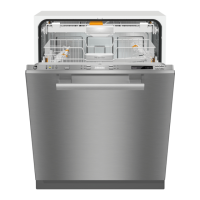Plumbing
86
The Miele Waterproof system
Provided your dishwasher has been in-
stalled correctly, the Miele Waterproof
system will provide extensive protection
against water damage throughout its
lifetime.
Water intake
Water in the dishwasher must
not be used as drinking water.
– The dishwasher must be connected
to the water supply in strict accor-
dance with current local and national
water authority regulations.
– The water used must at least comply
with national regulations for drinking
water quality.
If the water supply has a high iron
content, there is a danger of corro-
sion occurring on items being
cleaned in the dishwasher, as well as
the machine itself.
If the chloride content of the water
exceeds 100mg/L, the risk of corro-
sion to items being cleaned in the
dishwasher will be further increased.
– In certain regions (e.g., mountainous
regions), the water composition may
cause precipitates to form, requiring
the use of softened water for the
dishwasher.
– A backflow preventer is not required;
the dishwasher corresponds with the
applicable standards for the protec-
tion of drinking water.
– The water pressure (flow pressure at
the connection point) must be be-
tween 50 and 1000kPa (0.5 and
10bar).
If the water pressure is lower than
this, the fault message Intake will ap-
pear in the display (see “Frequently
asked questions”).
If the water pressure is too high, a
pressure reducer valve must be fitted.
– A faucet with a
3
/
4
inch male thread
must be provided on site. The valve
should be easily accessible, since the
water supply should be shut off
whenever the dishwasher is not in
use.
– The DN10 inlet hose is approx.
59" (1.5m) long terminating in a
3
/
4
inch female thread. A 59" (1.5m)
long flexible metal extension hose
tested to 140bar (14,000kPa) is
available as an optional accessory if
required. On no account may the inlet
filter or the flow regulator be re-
moved.

